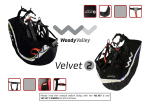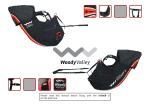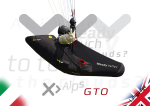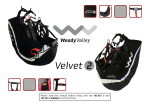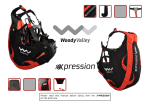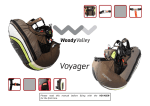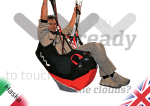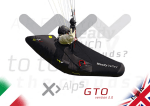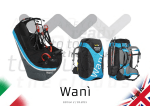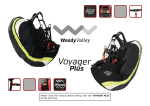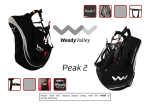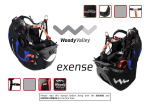Download Please read this manual before flying with the X-RATED 5
Transcript
Please read this manual before flying with the X-RATED 5 for the first time. THANK YOU! We would like to thank you for having chosen one of our products, and we invite you to read this important document, the User Manual for the harness. Please pay special attention to the two most important paragraphs, regarding: Insertion of the reserve parachute. The reserve parachute is a piece of equipment that may save your life. It must be treated so that it works correctly when it is required, whether this happens in two days’ time, or two years from now. Adjusting the harness. The harness forms the connection between the pilot and the paraglider, and it is an essential component in optimizing performance and the pleasure of flying. A bad harness that is well adjusted may enable you to fly well, but a good harness that is badly adjusted may put you off flying altogether. We are confident that this harness will give you greater comfort, control, performance and enjoyment in flight. We are conscious of the fact that reading an instruction manual is not an exciting experience. However, please remember that the respective product is not a citrus juicer or a mobile phone, and that correct use of the harness helps reduce the risk of flying accidents. This manual contains all the information necessary to assemble, adjust, fly and store your harness. Thorough knowledge of your equipment will improve your personal safety and your level of flying. The Woody Valley team SAFETY NOTE You have purchased a piece of equipment manufactured by us, and so you are aware of your identity as a paraglider pilot holding the respective pilot’s licence, and you accept all the risks connected to paragliding including the possibility of injury and death. The incorrect or inappropriate use of Woody Valley equipment greatly increases this risk. In no case can Woody Valley and the Woody Valley retailer be held responsible for personal injury caused to yourself or to third parties, or for whatever type of damage. If you have any doubts on the use of our equipment, please contact your retailer or the importer for your country. INDEX 1- GENERAL INFORMATION .................................................................................................................................................................................................................. 1 1.1- CONCEPT ....................................................................................................................................................................................................................................................................................1 1.2- X-RATED 5 PROTECTION ..........................................................................................................................................................................................................................................................2 1.3- S.O.S. LABEL..............................................................................................................................................................................................................................................................................2 2- BEFORE USING THE HARNESS ......................................................................................................................................................................................................... 2 2.1- ASSEMBLING THE DORSAL PROTECTION FOR X-RATED 5.........................................................................................................................................................................................................3 2.2- RESERVE PARACHUTE ................................................................................................................................................................................................................................................................3 2.2.1- Connecting the deployment handle to the deployment bag .............................................................................................................................................................................4 2.2.2- Connecting the reserve parachute to the harness ..............................................................................................................................................................................................4 2.2.3- Inserting the reserve parachute into the X-RATED 5 harness..........................................................................................................................................................................7 2.2.4- Reserve parachute deployment................................................................................................................................................................................................................................8 2.2.5- Closing the rear storage pocket................................................................................................................................................................................................................................8 2.3- HARNESS ADJUSTMENTS ............................................................................................................................................................................................................................................................9 2.3.1- Adjusting the sitting position ....................................................................................................................................................................................................................................9 2.3.2- Back position adjustment.........................................................................................................................................................................................................................................10 2.3.3- Shoulder-strap adjustment .....................................................................................................................................................................................................................................10 2.3.4- Chest strap adjustment ............................................................................................................................................................................................................................................11 2.3.5- Leg strap adjustment ................................................................................................................................................................................................................................................11 2.3.6- Stabilizing the harness..............................................................................................................................................................................................................................................11 2.3.7- Leg cover adjustment................................................................................................................................................................................................................................................12 2.3.8- Speed-system adjustment.......................................................................................................................................................................................................................................12 3- FLYING WITH THE X-RATED 5 ......................................................................................................................................................................................................... 13 3.1- PRE-FLIGHT CHECKS ................................................................................................................................................................................................................................................................13 3.2- POCKETS ..................................................................................................................................................................................................................................................................................14 3.3- HYDRATION BLADDER ...............................................................................................................................................................................................................................................................15 3.4- INSTALLING BALLAST AND USE OF THE COCKPIT .......................................................................................................................................................................................................................15 3.5- FLYING ABOVE WATER...............................................................................................................................................................................................................................................................17 3.6- TOW BRIDLE CONNECTION .........................................................................................................................................................................................................................................................17 3.7- LANDING WITH THE X-RATED 5 ..............................................................................................................................................................................................................................................17 4- PACKING THE HARNESS................................................................................................................................................................................................................. 17 5- FEATURES AND ASSEMBLY OF OPTIONAL ACCESSORIES ............................................................................................................................................................ 18 5.1- BALLAST BAG ...........................................................................................................................................................................................................................................................................18 5.2- EMERGENCY PARACHUTE CONTAINER WITH DEPLOYMENT ON THE LEFT ..................................................................................................................................................................................19 5.3- CONTAINER FOR A SECOND EMERGENCY PARACHUTE ...............................................................................................................................................................................................................19 6- MAINTENANCE AND REPAIR .......................................................................................................................................................................................................... 19 7- TECHNICAL DATA ........................................................................................................................................................................................................................... 20 1- GENERAL INFORMATION The equipment supplied should comprise: - Harness - Wooden seat plate - Hook-in karabiners - Handle for reserve parachute deployment - 2 spare elastic loops for fastening the reserve parachute - Speed-bar The optional extras comprise: - Front ballast pocket - Leg Cover (wind-proof protection) - Polycarbonate seat plate 1.1- Concept X-RATED 5 is a product that was developed entirely by Woody Valley in order to meet the needs expressed by our pilots. This paragliding harness was designed for a wide range of pilots, from those who like to fly cross-country to competition pilots. In fact, we dedicated special attention to comfort and safety in the construction of this harness. X-RATED 5 was designed for optimum comfort and use. Its aerodynamic design makes it attractive and striking. 1 Its reduced aerodynamic resistance provides considerable improvements in performance when using competition paragliders. In this fifth version, we have optimized the main structure to improve handling qualities and precision in thermals, while ensuring that passive safety remains high during high-speed glides from one thermal to the next. The harness also ensures optimum control of the glider in turbulence. Leg straps and shoulder straps are fitted with the “GET-UP safety system” which prevents the pilot from sliding out of the harness in the case that he or she has forgotten to fasten the leg-straps. 1.2- X-RATED 5 protection X-RATED 5 is fitted with a new LTF-certified dorsal foam protection piece with a thickness of 12 cm. 1.3- S.O.S. label This label, coloured red with white lettering, is readily visible in a pocket on the right shoulder-strap padding. It is easy to pull out, and it is fastened to the harness to prevent it from being lost. On the back of this label, you can write the information that you think should be given to rescue personnel in case of accident. 2- BEFORE USING THE HARNESS X-RATED 5 must be assembled by a qualified paragliding professional, such as your instructor. More specifically, great care has to be dedicated to inserting the reserve parachute into the harness in the correct way. Only after this has been performed should the pilot adjust the harness for maximum comfort. 2 2.1- Assembling the dorsal protection for X-RATED 5 Woody Valley recommends that assembly should be performed in the sequence detailed below. In case of doubts or any other problems regarding this procedure, please consult your instructor, your Woody Valley retailer, or the importer. Normally the product is supplied with dorsal protection in foam and rigid plastic. This is rolled and packed separately. In this case, follow these steps for its installation: a. Remove the foam protection from its packaging (once it has been removed from its packaging, it may take about 2 hours to return to its normal shape) b. Insert the narrowest part of the rigid sheet into the upper pocket, and the wider part into the lower pocket, as shown in the illustrations below. c. Insert the foam protection as shown in the photographs. The foam will automatically fit into the correct position. Do not place the foam protection below the cross-buckles on the back of the harness. Should it be necessary to remove the protection, just extract it following the steps above in reverse order. 2.2- Reserve parachute The housing for the reserve parachute is below the seat in the front part of the harness. The container is large enough for most reserve parachutes on the market today. The reserve parachute has to be linked to the harness before it is inserted into the built-in pocket. This connection takes the form of a dual bridle fixed to the harness at shoulder height, for better load distribution and to ensure a correct landing position in the case that the reserve parachute is deployed. This helps reduce the risk of injury to a minimum. The reserve chute bridle has a large central loop coloured red, and this is reinforced with a cover in Cordura 500. At the extremity of the loop, there is a Velcro band which enables the link with the reserve parachute to be held firmly in position. 3 2.2.1- Connecting the deployment handle to the deployment bag X-RATED 5 is supplied with a handle for reserve parachute extraction. It is identified with the number 6; this handle alone should be used for this purpose. The black loop attached to the handle itself should be passed into the loop on the deployment bag, and then the entire handle should be passed through its own loop and pulled tight. For easier extraction, the loop attached to the deployment bag should be positioned laterally with respect to the centre of the reserve parachute. If your deployment bag does not have this loop, please contact the retailer from whom you purchased the reserve parachute. 2.2.2- Connecting the reserve parachute to the harness There are three different methods of attaching the reserve parachute bridle to the harness bridle. First system: Use a screw-lock karabiner with a breaking strength of at least 2,000 kg. In this case, the bridles should be held in position within the karabiner using elastic bands, to prevent the karabiner from rotating and taking the strain laterally instead of vertically. The karabiner’s screw-lock should be tightly screwed shut to avoid any possibility of it opening accidentally. This type of connection can absorb a higher opening shock than the second system, and for this reason this is without doubt the recommended system. 4 Second system: The reserve parachute bridle is passed through the loop at the end of the harness reserve parachute bridle. The reserve parachute itself is then passed through the large loop in the reserve parachute bridle. This connects the two bridles. The loops should be pulled as tight as possible to avoid any chance of dangerous friction developing between the two bridles during the shock caused when the reserve parachute opens. To ensure that the link between the two bridles remains tight, remember to fasten the knot using the Velcro strip on the harness reserve parachute bridle. Third system: If you are using a reserve parachute with directional control and dual bridle, or if your reserve parachute in any case has a double-riser bridle, it can be connected to the harness using the two loops positioned at the base of the harness bridle, near the padded shoulder straps. In this case, the harness’ reserve parachute bridle will not be used, and so it should be folded, fastened using two elastic bands, and positioned under the cover behind the pilot’s neck. 5 The two connections should be made using screw-lock karabiners with a breaking strength of at least 1,400 kg. In any case, it is important to verify that the length of the bridle is sufficient to position the reserve parachute inside the harness pocket, and that there is sufficient play to enable the parachute to be taken out of the pocket without causing the reserve parachute deployment bag itself to open during extraction. IMPORTANT: To prevent anomalous lateral loads, the bridle should be attached to both the loops on the shoulder straps. Not to just one of them. 6 2.2.3- Inserting the reserve parachute into the X-RATED 5 harness Insert the reserve parachute into the pocket of the harness, so that the handle is visible and facing outwards, and the loop connecting the handle to the deployment bag is facing upwards. Thread a thin cord (such as paraglider riser cords) through each elastic loop. This will help close the pocket. Thread the elastic loops into the smallest of the eyelets on the pocket flaps. Close the flaps following the order shown in the photographs below. Push the metal pins on the handle into the elastic loops and under the transparent cover. It is essential to remove the cords after this operation. The cords should be pulled out slowly in order not to damage the elastic loops by excessive friction. Lastly, the handle should be positioned under the elastic cover. 7 IMPORTANT: Every new combination of reserve parachute and harness or the external container assembled for the first time should be tested by an official harness or reserve parachute dealer, or by a flying instructor. Deployment of the reserve parachute should be perfectly feasible from the normal flying position. 2.2.4- Reserve parachute deployment It is vital to feel periodically for the position of the reserve parachute deployment handle during normal flight, so that the action of reaching for the reserve parachute handle becomes instinctive in an emergency. In emergency situations, the deployment procedure is as follows: Look for the reserve parachute handle and grasp it firmly with one hand. Pull the handle outwards in order to extract the reserve parachute from the harness container. Look for a clear area, and, in a continuous motion, throw the reserve parachute away from yourself and the paraglider. After the reserve parachute has opened, avoid entanglement by pulling in the paraglider, gripping at least one D line, or the brake lines, in order to collapse the glider. On landing, adopt an upright body position, and ensure that you perform a PLF (Parachute Landing Fall) to minimize the risk of injury. 2.2.5- Closing the rear storage pocket After having placed all objects required into the rear storage pocket, close it by sliding the polycarbonate part into the slot in the "hood," as shown in the photos below. 8 2.3- Harness adjustments It is important to remember that the size of your X-RATED 5 must be chosen according to your height, and not according to seat width. Differently to harnesses in which the pilot flies in a basically "seated" position, in which the height of the back support is not fundamental for comfort, in a harness in which the pilot adopts a more supine position the height of the back support is fundamental in obtaining good comfort and a correct flying position. This means that it is important to choose the right size, ensuring that the height of the back is correct, without worrying about seat width. Seat width can easily be reduced by cutting the sides, up to a maximum of 1.5 cm on each side. The X-RATED 5 harness provides a number of methods of adjustment so that the pilot can fly in the ideal position. A little time has to be invested in finding the optimum position, but this effort will be rewarded by exceptional comfort in flight. Before making any adjustments, the reserve parachute must be in position. To find the best position, we suggest hanging in your harness from a suitable point of support, simulating flying position and conditions. For this reason, it is best to place all the things that you would normally carry with you when flying into the back pocket (rucksack, accessories, extra clothing and other sundry items). IMPORTANT All adjustments have to be performed symmetrically on both sides. After having adjusted the harness completely for the first time, repeat all the adjustment steps, and ensure that all straps are tight. 2.3.1- Adjusting the sitting position The first adjustment procedure regulates the angle between the thighs and the back (depth of seat). This angle can be varied from about 90° to 130°, by adjusting the straps running through the lateral trimmers. The lateral straps help you adjust the sitting angle, and they provide leg support on long flights. For X-RATED 5, it is advisable to ensure that the seat does not slope upwards too steeply, because this would cause the legs to press against the front edge of the seat, obstructing blood flow and causing discomfort. 9 2.3.2- Back position adjustment By adjusting the back (using the trimmers higher up on the side), the pilot adjusts the inclination of the torso with respect to the vertical axis in flight. A good flying position, improving control of the glider, is obtained by positioning the face at about 15 cm from an imaginary line between the two karabiners. 2.3.3- Shoulder-strap adjustment Shoulder-strap adjustment enables the harness to be adjusted to the pilot’s height. The adjustment buckle is situated low down, near the rear edge of the seat. The shoulder-straps also support part of the torso weight to improve comfort. After that you have determined the correct position for the seat and back, adjust the shoulder straps so that they are in contact with your shoulders, neither too loose nor too tight. 10 2.3.4- Chest strap adjustment The chest strap which controls the distance between the two karabiners can be adjusted from 40 to 55 cm. For the first flight with X-RATED 5, we suggest setting the chest strap to the minimum length, then locating the preferred length in flight by means of gradual adjustment. When the chest strap is shorter and tighter, stability is greater. An excessive distance between karabiners does not improve glider performance, and tightening the chest strap excessively may exacerbate the "twist" effect that may follow an asymmetric collapse of the sail. 2.3.5- Leg strap adjustment Because the leg straps are attached relatively high up, the pilot has considerable freedom in thigh movement. Normally, the manufacturer’s original setting should be satisfactory. However it is important to try reaching the correct seated position in the launch phase without using your hands, by testing the movements in a flight simulator. If you cannot achieve the seated position without using your hands, the sitting angle has to be checked, and then the leg straps should be readjusted. 2.3.6- Stabilizing the harness This small but important adjustment makes it possible to stabilize the harness when the pilot activates the speed-system, preventing excessive inclination of the back which would produce discomfort in flight. The functioning of this system is very simple: when you depress the speed-pedal, the strap is put into tension. This in turn produces a greater tension throughout the entire straps system, increasing the stability of the harness. To locate the optimum position for this adjustment, we advise the pilot to wear the harness and simulate the flying position by hanging from an appropriate fixed point, adjusting the system so that it is in slight tension. 11 2.3.7- Leg cover adjustment The leg cover can be adjusted according to leg length by means of four buckles inside the cover, as shown in the illustration below. We suggest adjusting the leg cover so that the legs are fully extended and the ankles are at 90 degrees, to prevent any possible constriction that could cause discomfort to the legs during flight. 2.3.8- Speed-system adjustment X-RATED 5 includes a three-step speed system, with one rigid and two flexible segments. Its length should be adjusted only after having located optimum seat position. To adjust the system correctly, the pilot has to adopt a flying position in the harness, suspended from a flight simulator, and hook into the risers of the paraglider. Another person then helps by supporting the risers, so the pilot can adjust the length of the speed-system cords. When no pressure is exerted on the speed bar, the bar must be at a distance no greater than 10 cm below the front of the harness. If the speed-bar cord is too short, it could cause a constant force on the bar during flight, so that the accelerator is unintentionally engaged at all times in flight. It is safest to take off with the speed-bar a little too long, progressively shortening it during the next flights. Remember that all adjustments have to be performed symmetrically, on both sides. If you wish to change the speed-pedal itself, rest assured that this harness can be used with all conventional types of speed-system. The speed-bar cords are threaded firstly through the eyes fixed to the elastic in front of the board, and then into the harness through the eyes near the front corners of the seat, after which they are led through the pulleys near the rear corners of the seat and brought directly up to connect to the paraglider risers. In addition, the two elastic straps that Woody Valley supplies with all the speed pedals that it manufactures have to be installed. The elastic straps are fixed by means of loops to the two loops on the underside of the pedal. This ensures that the speed pedal is always properly extended and ready for use. 12 Friction pulleys are available as optional extras. These are installed in order to reduce the effort necessary to keep the speed pedal extended. X-RATED 5 is fitted with two extra loops specially for these special pulleys, for which the attachment point is different because of the larger size of these friction pulleys. The standard pulley can be left in its original position. If it interferes with the operation of the friction pulleys, it can be removed by cutting the support. The pulleys can be purchased direct from Woody Valley, from your importer or local retailer. 3- FLYING WITH THE X-RATED 5 3.1- Pre-flight checks For maximum safety, use a complete and consistent system of pre-flight checks and repeat the same mental sequence every flight. Check that: all buckles are fastened. Take particular care in the case of ice or snow. Always clean off snow or ice before fastening buckles; the reserve parachute handle is fastened in its correct position, and the pins are firmly inserted; pockets and zips are closed; the paraglider is connected correctly to the harness, and that both karabiners are locked closed by means of their locking system; the speed bar is attached correctly to the glider. 13 3.2- Pockets X-RATED 5 has a large dorsal pocket and various side pockets. Two of these are close to the main karabiners, very handy and with safety loop for radio and mobile phone. It also has another two very large side pockets. The instrument holder was designed for easy removal from the cockpit, so that all instruments are available during briefings, and to protect them from any compression caused by harness packing. The instrument holder can be detached by means of the zip, and in addition it has a 2 mm-thick neoprene cover to protect the instruments from any possible sources of damage. 14 3.3- Hydration bladder X-RATED 5 was specifically designed for the installation and use of a hydration bladder. Place your hydration bladder in the compartment shown in the photo, located in the rear storage pocket. Thread the drinking tube through the eye in the harness. Pass the tube outside the shoulder strap and, to ensure that it is ready for use at all times, thread it under the elastic loop as shown in the photo. 3.4- Installing ballast and use of the cockpit X-RATED 5 has two ballast compartments, one under the seat, and the other in the cockpit, under the instrument holder. The ballast compartment under the seat has a capacity of about 4/5 litres, and it was designed so that the ballast drain tube can emerge from the harness. The ballast bag (sold separately) should be placed inside the pocket shown in the photo, ensuring that the drain tube is positioned in correspondence with the eye in the pocket. Thread the tube through the hole and close the zip. In order to bring the tube out of the harness, it should be threaded through another eye on the left hand side of the harness. If the procedure has been completed correctly, the water release tap will emerge on the left-hand side, from the respective opening (as shown in the photo below). 15 The ballast compartment under the instrument holder operates in approximately the same manner. Open the zip of the fabric flap, which becomes the ballast bag container. Place the ballast bag into position so that the drain tube is in correspondence with the eye. Run the drain tube between the seat angle adjustment strap and the main harness strap, and then pass it out of the harness. If you decide to use, or not, the ventral ballast container, the cockpit has to be adjusted so that during flight it does not impede visibility or impair comfort. There is a triangular piece of strapping sewn onto both sides of the container, with a buckle for fastening and adjustment. By adjusting the buckle position and strap length, the designed height and angle of the surface on which the instruments rest during flight can be adjusted. The volume of the cockpit can be reduced by means of two adjustment bands running along the lower section of the cockpit. 16 3.5- Flying above water It is inadvisable to use the X-RATED 5 harness on flights over water. In the event of the pilot being forced to land on the water, the foam dorsal protection may force the harness into a position that holds the pilot underwater. Woody Valley recommends the use of a suitable lifejacket when flying over water. 3.6- Tow bridle connection The X-RATED 5 harness can be used for towed launches. The tow bridle release should be hooked directly to the main karabiners, ensuring that the karabiners are positioned with the opening bar facing the rear. For further details, refer to the documentation provided with your tow release, or ask a qualified towing instructor at your flying site. 3.7- Landing with the X-RATED 5 Before landing, slide your legs out and off the seat surface, so that you take up a standing position. Never land in the seated position; it is very dangerous for your back even if you have foam dorsal protection, which provides exclusively passive protection. Standing up before landing is an active safety precaution, and it is much more effective than passive forms of protection. 4- Packing the harness The X-RATED 5 harness can be packed into the rucksack both with the paraglider hooked onto the karabiners (fig.1) and separately. Fold the front tip onto the seat, and draw the two karabiners together (fig.2). Place the folded paraglider onto the harness (fig.3). Cover harness and paraglider with the rucksack (with the back upwards, fig.4). Turn over the entire package and close the zip (fig.5). Fold the expanding "hood" into the harness' rear pocket, and bend down the top part until the rucksack can be closed completely. In the upper part, there is enough room for the helmet. 17 5- FEATURES AND ASSEMBLY OF OPTIONAL ACCESSORIES 5.1- Ballast bag Our ballast bag has a carrying handle, drain pipe and tap. It can contain up to 7 litres of water, and it can be inserted into the central ballast compartment or the ballast compartment under the seat. 18 5.2- Emergency parachute container with deployment on the left Woody Valley offers an important optional for your X-RATED 5. The container for the emergency parachute can be mounted on the left-hand side, for use by lefthanded pilots. This optional feature is obtainable only on order, and only when purchasing a new harness. 5.3- Container for a second emergency parachute Woody Valley offers another important optional feature for your X-RATED 5: a second container for an emergency parachute, built in under the seat. In this case, the ballast container under the seat will no longer be present. This optional feature is obtainable only on order, and only when purchasing a new harness. 6- MAINTENANCE AND REPAIR Check the harness after every impact, bad landing or launch, or in the case that there are signs of damage or excessive wear. We recommend having your harness checked by your retailer every two years, and replacing the main karabiners every two years. To prevent unnecessary wear and deterioration of the harness, it is important to avoid its scraping against the ground, rocks or abrasive surfaces. Do not expose the harness unnecessarily to UV radiation (sunlight) outside normal flying activities. Wherever possible, protect the harness from humidity and heat. Store all your paragliding equipment in a cool, dry place, and never put it away while damp or wet. Keep your harness as clean as possible by regularly cleaning off dirt with a plastic bristle brush and/or a damp cloth. If the harness gets exceptionally dirty, wash it with water and a mild soap. Allow the harness to dry naturally in a well-ventilated area away from direct sunlight. If your reserve parachute ever gets wet (e.g. in a water landing) you must remove it from the harness, dry it and repack it before putting it back in the container. Repairs and replacement of harness components cannot be performed by the user, but exclusively by the manufacturer or staff authorized by the manufacturer. The manufacturer and authorized service staff alone can use materials and techniques ensuring correct product functionality and its complete conformity to product certification. The harness can be washed using a tepid solution of water and mild soap. Zip fasteners should be kept clean and lubricated with silicone spray. In the case of making any request to an official retailer or Woody Valley for maintenance operations, please quote the complete identification number shown on the silver label in the rear pocket. We hope that you enjoy great flights and happy landings with X-RATED 5 ! 19 7- TECHNICAL DATA Distance between karabiner and seat Size M cm 43,5; L cm 46; XL cm 48,5 Distance between karabiners (min. max.) Size M cm 40/55; L cm 40/55; XL cm 40/55 Size of polycarbonate seat, size M Width rear 32 cm; Width front 29,5; depth 37 cm Size of polycarbonate seat, size L Width rear 34 cm; Width front 31,5; depth 39,5 cm Size of polycarbonate seat, size XL Width rear 36 cm; Width front 33,5; depth 42 cm Total weight of X-RATED 5, size L, complete with reserve parachute handle, karabiners and protection 7,95 kg Type of protection Protection in 12 cm foam Type of straps GET-UP Certification LTF GZ-7235/10 Reserve parachute housing Built-in container under the seat, with lateral handle. Every effort has been made to ensure that the information contained in this manual is correct, but please remember that it has been produced for guidance only. This owner's manual is subject to change without prior notice. Please check at www.woodyvalley.com for the latest information regarding the X-RATED 5 harness. Latest update: AUGUST 2010 20

























